(Author’s Note: This is the “zero’th” part of what will be a three part series on printed circuit board milling. This article is where I decide on what milling machine to get and the reasoning behind it, so there is no actual PCB milling here. The point then? Document the purchase decision making process as it’s made, then look at the final results later and see where it went right or wrong.)
I never thought I’d say it, but Chinese “knock-offs” have really found their niche. I’m not being facetious – in all honesty there is actually something really wonderful that they are accomplishing. It all starts with someone on a maker’s web site like Instructables or mikrocontroller.net where someone comes up with a great little project. Like, say, for a multi-component “transistor” checker. Designers create these “open source” projects which are intended for everyone to enjoy, and they document everything and just release all the specs and design documents so that not only can anyone build it, but also anyone can improve on it. Sometimes, for the better projects, a whole community builds up around the project. Once that happens along comes some Chinese manufacturing company and they take those detailed instructions and mass produce a kit for it. Now, suddenly, not only are the specs available but now anyone can put it together for $15. Win/win/win. A win for the author, who finds that once anyone can build the project he designed the community really begins to thrive. A win for the consumer and the project community who get fantastic equipment at a fraction the traditional cost, and a win for the manufacturer who was incentivized to do all this by the low R&D cost and who makes some money selling the kits. This is just fantastic. Hardware manufacturers doing for maker projects what Red Hat and Ubuntu did for Linux.
I’ve taken advantage of this process a few times recently. What I’ve just discovered is that this phenomena has reached the wonderful world of the desktop CNC milling machine! I was aware of the many Chinese clones of 3D printer project kits, and had even played with the idea of getting one, but I hadn’t been aware until now that you could get a desktop sized budget CNC mill.
Background
My SB-230 project has required me to do some PCB etching recently. While I’m no stranger to PCB etching – I’ve done quite a few etched boards, but almost all my work has been hand done and I want a better (faster and more professional) solution. I’ve only tried something fancier twice. Once with photo-resist and other with direct-to-PCB inkjet printing. Both worked, but one was ruinously costly (factoring in the failed attempts) and the other was perhaps more time consuming and fussy than doing it by hand. It was while researching a printer I could use as a dedicated (and more reliable) PCB resist printer that I just yesterday discovered the Chinese CNC mill.
Here is the video that really got my attention. If you want your attention got too, advance to 6:00 and watch from there.
Now I could use many reasons to justify getting one of these machines. Reduced PCB production cost (no photo resist boards, not even any etchant to buy), an increase in the complexity of boards I can do myself, ease of production. Really, though, once I saw a complex double-sided board come to life almost like it was replicated in Star Trek, I knew I couldn’t go back. My hand stenciled etched PCB days are officially over.
I have paid for one today. You can skip to the end and find out which one, or you can read on for some of the thoughts I had along the way and the reasoning I used to select the model I did. Then, when it arrives, we can all see whether or not the unit I chose meets the intentions behind it.
Selection Criteria
Seeing that two days ago I didn’t even really know these things existed, I don’t really have a mature set of selection criteria. It’s fairly obvious though, for the most part, what is needed here:
- The obvious #1 criterion is that it must be able to accurately mill PCBs, preferably in any size I will reasonably want to use.
- It must be inexpensive. Hard upper limit of $500, much less if possible – this is, after all, a fairly impulse buy intended to reduce costs for my ham radio projects, not a whole new hobby.
- With #2 being said, where cost allows, it should still be as “future proof” as possible. Preference will be given to units that can be upgraded and or used perform other milling tasks.
Choosing the candidates
I am no stranger to buying things from Chinese manufacturers and vendors. I’ve been doing business on Ali Express for some time. Most of the basic electronic components for my electronics workbench come from there nowadays. This, however, is the most major purchase I have contemplated from there to date and I want to make sure I get this right. Buying from Ali Express has pitfalls. For one thing you can never forget when dealing directly with Ali Express merchants is that what you and I consider the “little white lie”, the answer we give when a friend asks us whether we like his tie or not, that is the same way they think about doing business. Over there exaggerating, insinuating, and sometimes outright lying about what a product can do, or what it’s made out of is simply expected. This makes me nervous when contemplating a more significant purchase. The rule to go by is never, ever make an impulse buy on Ali Express. Search, search, and more search. Never buy the first thing that comes up. Sort the search by number of orders to see what’s popular, then sort by price, sort by consumer rating, sort by what’s newest and see what’s coming up, and then look at the bottom of that list to see what’s the current “old guys” that are being discontinued. Also you should come up with every synonym you can think of for what you want to buy, because the title for that one listing you really want may have been badly translated or worded differently. And even when you think you’ve found the perfect match, keep refining your search terms and keep looking.
I could (and did) look at the machines on other shopping sites too. Amazon and eBay, of course, and some of the dedicated electronics hobby sites. Amazon tends to be people in North America who think they can make money buying the Chinese kits and reselling them at a profit, and eBay (for Chinese merchandise) tends to be Ali Express with fewer vendors. Both of them can be a bit safer to deal with, but in the end, if it’s made in China, you will find likely it cheaper on Ali Express.
Going on from here you need to know my theory of product lifecycles. In a nutshell my theory states that most any product will have three basic phases. Phase one is the prototype/early adopter phase, where they are expensive and basic and big. This is the proof of concept where a company sees if there is any market at all for something. Then you get phase two, this is what I call the “feature phase”. This is where they have the proof of concept and where they want to capture the market but don’t quite know exactly how broad the market is and so they throw every feature they can think of at it. The quality at this phase is generally very good, since they have worked out the initial kinks in phase one and they are careful to make sure the new features they are throwing in are well tested. Also, frankly, since they are still scoping the market during phase two they haven’t figured out how to skimp yet. And lastly there is phase three, the final mass-appeal phase. This is where they have determined what the people in the center of the bell curve want, and they provide only the bare minimum to appease them at the lowest possible production cost. They ruthlessly cut out any feature not absolutely needed or that doesn’t create a great advertising talking point. Those are the three phases of my product lifecycle theory. It is, of course, the phase two product I tend to search for.
Now when I say I’m looking for a milling machine, I mean a milling machine kit. The ones that are out based on maker website milling machine projects and prototypes. While searching Ali Express and looking at the current crop of CNC milling machines kits I found evidence of all those phases. The phase three CNC mills are the cheap milling machines with as much plastic as metal. These are the main ones I found in this category (they are all generally named “CNC XXYY” where the XX and YY are the dimensions in CM the spindle can reach – the size of project you can work on):
- CNC 1610 / 2418 / 3018 – Three sizes of the same essential unit. Can get a fairly large (in the size class I’m considering) platform at a very low price, but there is a lot of plastic in key places making me worry about precision and durability. They also generally come with the option of adding on a 500-5500mw laser. The z-axis motion is only 3cm deep, but that’s ok because they have spindle motors that probably couldn’t work anything else except the PCB. These are very “phase three” products.
- CNC 2417 – A slightly older model not quite as “phase three-ified” yet. Seems more robust. The three support rods for the z-axis and spindle makes me believe it’s likely quite precise. This one also comes with the benefit of a web page dedicated to showing that PCB milling is quite viable on this exact model.
- CNC 2632 – A good sized table, and the ability to upgrade the Z axis to a fully metal mount and a 300W spindle motor make this one attractive. If the link doesn’t work, and you want to find this one, make sure the listing says “FEUNGSAKE” or you’re not looking at one I’m referring to. There are other models named “CNC 2632” that are not the same.
There also seem to be some phase 2 models left:
- CNC 3040 – This seems to be an early attempt to take the open source projects that these were born from and turn them into an actual end-user product, rather than a hobbyist kit. Features include a large table and this is one of the few non-professional ones that I found where it’s the gantry that moves in the Y axis over the table and not the table under the gantry. Because it’s fully assembled, though, in order to bring it in at a price point that doesn’t put it out of reach of hobbyists they cut costs in other ways and the table and gantry are mostly MDF.
- CNC 2030 – This one is another of the “FEUNGSAKE” models. I have only found one Ali Express vendor that even carries this item. It is not popular, and when I first saw it on my search I initially mistook it for the CNC 2632 shown above. Once I recognized it as a distinct model and looked at it closely, it looked to me very much like an earlier version of the CNC 2632. It comes with a 300W spindle motor and an all-metal z-axis, like the option on the 2632 above. It has a very professional, solid look to it and overall it seems to have more attention to detail and more nice touch features.
If any of the links above are broken (Ali Express listings come and go quite quickly), for the most part you can just go to Ali Express and search for “CNC xxyy” and you will see the machine I was referring to.
Trimming the List
You’ve met all the contestants, now it’s time to narrow the field. I whittled out the 1610/2418/3018 series pretty early because, despite the very attractive pricing, they are just so very phase three bare bones put-in-the-very-least-we-can-put-in-and-still-call-it-a-milling-machine machine. I just couldn’t trust that I would be able to do anything with them. Plastic guides make for poor tolerances.
The 2632 was eliminated when I discovered the 2030. With the 300W spindle option on the 2632 they were similar in price. The added few cm of table space on the 2632 looks to me like a marketing ploy by the designers of the 2632 to draw attention away from the features they stripped out of the 2030 to save money. A typical “see, we made it bigger, so please don’t notice the quality has diminished” situation.
The 3040 was something I found after I had already made my purchase. I had a bit of a of a “my heavens did I miss something good here” moment when I noticed the moving gantry but that was before I realized the whole thing, even the table, was MDF. A particle board table on a milling machine is akin to having a machine that manipulates a hot knife and having the structural bits made out of butter. Not a good recipe for a machine I want to use more than once.
Finalists
That culling leaves the CNC 2417 and the CNC 2030 as the final two candidates. So a little more on each:
CNC 2417: This unit, as mentioned above, has a whole web site dedicated to showing how it can be used to make printed circuit boards, so obviously it functions in the primary role I intend my machine for. That is huge, since using desktop milling machines to make PCBs is far from mainstream and knowing, not just believing, that a particular desktop milling machine will work in that capacity is a huge benefit. Looking at the construction of this machine it is no surprise to me that it works well for PCBs. I listed the 2417 as a phase three machine, but really it’s more like a phase 2.5. Even though it has stripped out the metal table guide brackets in favour of cheaper plastic, it still has some of the marks of quality of a phase two product. Almost all machine have two guide rods for the z-axis, but this machine has three. That makes it look to me like the z-axis has good support and tight tolerances. The tighter the tolerances, the more accurate the grinding on your PCB. There is a 6.5cm range for the z-axis, which is the best of all the ones I’ve looked at, though a video I saw of this unit shows there is only 5cm of vertical clearance behind the spindle. However the low-power 80W spindle is mounted in plastic, and likely can’t be upgraded (except for the lasers you can swap the spindle out for) without replacing the entire z-axis which will likely not be cost effective on this unit. But if all I ever want to do with my machine is printed circuit boards, then this will be the machine for me, because it’s at a very attractive price point.
CNC 2030: In looking at the desktop milling machines on Ali Express, sometimes it seemed to be a sea of vendors all trying to cut out everything not absolutely necessary to the basic functioning of that model so that they can be slightly bigger than the next guy at the same price. In that sea of deliberate mediocrity, the CNC 2030 stood out as a classic phase two “diamond-in-the-rough” product. It’s almost impossible to find, which of course isn’t itself a direct indicator of quality, but given the general trend on Ali Express toward cheaper, seeing a one-off item can be a trigger to look at something closely. When something gets discontinued on Ali Express it’s either because there are problems with it that are so serious even an Ali Express vendor can’t sweep them under the carpet, or the manufacturer found a way trim yet another bit and make it cheaper. I’m fairly certain this one was discontinued in favour of the 2632 as mentioned above, and comparing the two I can see the markers of real quality on this one. From the outset it just looks sturdy – there isn’t a lick of plastic in any structural capacity anywhere on it. The electronics discreet and look to be over-spec for what they are running. The control board is actually a four axis control board, which means I could add another axis to this later on. The z-axis is a fairly deep 6cm, the second best of all the ones I’ve looked at, and the full 6cm is available in clearance behind the spindle. This one also has some of those little touches everyone else has stripped out, like nice knobs on the axes for manual adjusting and end caps for the framing elements. The most major single benefit is that the all-metal z-axis spindle motor mount is sturdy enough and large enough that I could upgrade it with an 800W or even 1500W spindle motor. This will allow actual milling – as in aluminum or brass parts. In general, though, it’s the attention to detail which is attractive about it. The major drawback of this model, of course, is the cost, and the fact that despite its quality difference it’s not a solution proven to work well for making PCBs like the 2417 is.
Final Decision
It’s easy to see my lean toward the 2030. Even though I came into this looking strictly for a PCB making solution, it’s just as foolish to ignore future expansion as it is to give in to feature creep. When looking at the 2417, I got sidetracked for a while delving into the neat things I could do with it if I got the laser head for it too. It was when I realized that a 2417 with a 5500mw laser was the same price as the 2030, that was when I put the kibosh on the 2417+laser and made the decision to go with the quality unit. The laser I can get later. The base-level quality and expandability I will get out of the box with the 2030 I would have to re-buy if I want it later down the road should I go with the 2417.
With the decision made, I want to write a set of articles on using a desktop milling machine to make PCBs. So consider this part zero (pre-purchasing considerations) of a set of pieces on using CNC milling machines to make PCB boards. Part 1 will be the arrival and construction of the unit up to a proof-of-concept board. Part 2 will focus on software. Assuming that the machine works as intended, the wrap-up will be an analysis of the purchase decision and deciding whether the right unit was chosen.
Until then, I give you the CNC 2030 3-Axis Milling Machine, winner of the 2017 VA1DER PCB desktop milling machine bidding process!
- Front view
- 3/4 view
- Side view, strong z-axis mount
- Rear with electronics – the discreet boards makes upgrading any one part much easier
- Axis adjust knob, not many models have this any more
- The undercarriage

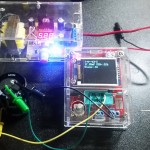
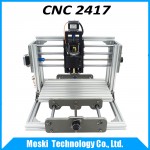
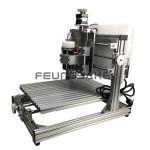
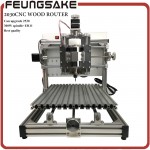

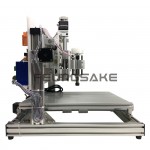
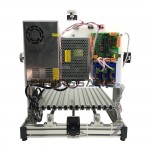
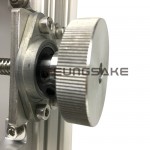
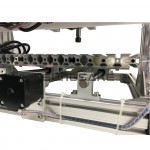
It’s two weeks on and my machine is finally going to arrive, according to FedEx, either tomorrow or Monday. I’ve learned a few more things since then:
While the Chinese supply chain and online vendor system is difficult for outsiders to understand, I gather that the vendor I ordered from doesn’t keep much inventory and works on a “just-in-time” basis. I suspect they order the stuff they need as they get orders. Labour is cheap, so as they get orders for a kit they then likely turn around and order the stuff they need to make that kit. When the stuff arrives they can then get people to custom assemble the kit by hand. This means that it didn’t ship right away – it took over a week. That was a little nerve wracking.
I’ve confirmed with the vendor that the CNC 2632 is indeed a later version of the one I purchased, the CNC 2030. I don’t know if that means the CNC 2030 is going to go away or not. I’ll update when I find out more.
Hi Kurt,
We also plan to buy CNC 2030 (FEUNGSAKE) for PCB production. Are you satisfied with this CNC machine?
Regards,